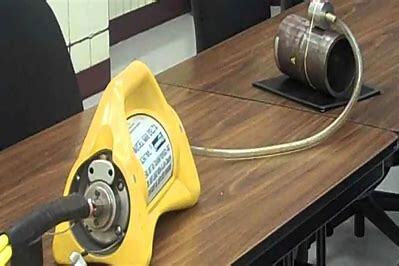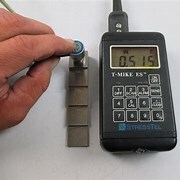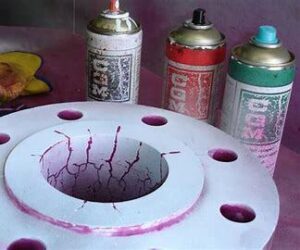Conventional NDT
Conventional NDT: An Introduction to Non-Destructive Testing
Non-Destructive Testing (NDT) is a crucial process used in various industries to test and inspect materials, components, and systems without causing any damage. Conventional NDT techniques, also known as traditional NDT, are some of the most common and widely used methods of NDT. They involve the use of basic equipment and techniques that have been in use for decades.
Conventional NDT techniques can be used to inspect materials such as metals, plastics, ceramics, and composites. These techniques include visual inspection, magnetic particle testing, liquid penetrant testing, eddy current testing, radiography, and ultrasonic testing.
Visual inspection is the simplest form of NDT, which involves visually examining the surface of a material or component for defects such as cracks, corrosion, or other damage. Magnetic particle testing is used to detect surface and slightly subsurface discontinuities in ferromagnetic materials. Liquid penetrant testing is used to identify surface-breaking defects in non-porous materials such as metals, plastics, and ceramics.
Eddy current testing is a technique that uses electromagnetic induction to detect surface and subsurface discontinuities in conductive materials. Radiography is a technique that uses X-rays or gamma rays to examine the internal structure of materials or components. Ultrasonic testing uses high-frequency sound waves to detect internal flaws in a material or component.
Conventional NDT techniques have several advantages over other NDT methods. They are generally less expensive and require less specialized training and equipment. They are also more widely accepted and recognized by industry standards and codes.
In conclusion, conventional NDT techniques are a reliable and cost-effective way to inspect and test materials and components without causing any damage. They have been in use for decades and continue to be widely used in various industries. Understanding the basics of conventional NDT techniques can be helpful for anyone involved in materials testing, quality control, or manufacturing.
Conventional NDT Welder Qualification and Recertification: Ensuring Quality Welding
Welding is an important process in various industries, and it is crucial to ensure the quality and safety of welds. Non-Destructive Testing (NDT) is an effective method of testing and inspecting welded joints without causing any damage. One important aspect of ensuring quality welding is through the qualification and recertification of welders in conventional NDT techniques.
Welder qualification is the process of assessing the skills and knowledge of a welder to ensure that they are competent to perform the required welding tasks. Conventional NDT techniques are commonly used to qualify welders, and they include visual inspection, magnetic particle testing, liquid penetrant testing, radiography, and ultrasonic testing.
Visual inspection is the simplest form of NDT and involves visually examining the surface of a weld for defects such as cracks, porosity, or other damage. Magnetic particle testing and liquid penetrant testing are used to detect surface and slightly subsurface discontinuities in welds. Radiography and ultrasonic testing are used to examine the internal structure of welds and detect any defects.
Welder recertification is the process of renewing a welder’s qualification after a certain period to ensure that they are still competent and up-to-date with the latest welding techniques and technologies. Conventional NDT techniques are also used in welder recertification to ensure that welders are still capable of producing quality welds.
Conventional NDT techniques are essential in welder qualification and recertification as they provide a reliable and non-destructive way to inspect and test welded joints. This helps to ensure the quality and safety of welds and prevent any potential failures or accidents.
In conclusion, conventional NDT techniques are crucial in ensuring the quality and safety of welded joints. Welder qualification and recertification using conventional NDT techniques can help to ensure that welders are competent and up-to-date with the latest welding technologies and techniques. Understanding the importance of conventional NDT in welder qualification and recertification can be beneficial for anyone involved in the welding industry.

Radiography Testing using X-Ray / Gamma Ray: A Crucial NDT Technique
Radiography testing is a non-destructive testing (NDT) technique that uses X-rays or gamma rays to examine the internal structure of materials and components. This technique is widely used in various industries to inspect welds, castings, forgings, and other critical components. Radiography testing is a reliable way to detect internal defects such as cracks, voids, and inclusions that may not be visible on the surface.
Radiography testing using X-rays or gamma rays involves passing radiation through the material or component being inspected and capturing the resulting image on a film or digital detector. X-rays and gamma rays have different energy levels and are used based on the material and the thickness of the component being inspected. X-rays are commonly used for thinner materials, while gamma rays are used for thicker materials.
Radiography testing has several advantages over other NDT techniques. It can be used to inspect large areas quickly and accurately, and it can detect both surface and internal defects. Radiography testing is also a non-contact method, which means that the component being inspected does not need to be physically touched, reducing the risk of damage or contamination.
Radiography testing is a crucial NDT technique in various industries such as aerospace, automotive, construction, and manufacturing. It is commonly used to inspect welds, pressure vessels, pipelines, and other critical components. Radiography testing helps to ensure the quality and safety of components and prevent any potential failures or accidents.
In conclusion, radiography testing using X-rays or gamma rays is a crucial NDT technique in various industries. It is a reliable and non-destructive way to inspect the internal structure of materials and components and detect any defects. Understanding the basics of radiography testing can be beneficial for anyone involved in materials testing, quality control, or manufacturing.

Manual Ultrasonic Testing: A Versatile Non-Destructive Testing Technique
Manual Ultrasonic Testing (UT) is a non-destructive testing (NDT) technique that uses high-frequency sound waves to inspect and measure the internal structure of materials and components. It is commonly used in various industries such as aerospace, automotive, construction, and manufacturing to detect internal defects such as cracks, voids, and inclusions that may not be visible on the surface.
Manual UT is a versatile NDT technique that can be used on a wide range of materials such as metals, plastics, ceramics, and composites. It can also be used to inspect different types of components such as pipes, plates, forgings, castings, and welds. Manual UT involves sending ultrasonic waves through the material or component being inspected and analyzing the reflections to detect any internal defects.
Manual UT has several advantages over other NDT techniques. It is a non-destructive method, which means that the component being inspected does not need to be physically touched, reducing the risk of damage or contamination. It can also be used to inspect large areas quickly and accurately, and it can detect both surface and internal defects. Manual UT is a cost-effective way to inspect materials and components and ensure their quality and safety.
Manual UT requires skilled technicians who are trained in using specialized equipment and interpreting the results. The technician must be able to identify and analyze the ultrasonic signals and determine whether any defects are present. The results of the manual UT inspection are usually recorded in a report, which includes the location and size of any defects and their severity.
In conclusion, manual ultrasonic testing is a versatile and reliable NDT technique that can be used on a wide range of materials and components. It is a non-destructive method that can detect both surface and internal defects and ensure the quality and safety of materials and components. Understanding the basics of manual UT can be beneficial for anyone involved in materials testing, quality control, or manufacturing.

Magnetic Particle Testing: A Reliable Non-Destructive Testing Technique
Magnetic Particle Testing (MPT) is a non-destructive testing (NDT) technique that is commonly used to detect surface and near-surface defects in ferromagnetic materials. This technique is widely used in various industries such as aerospace, automotive, construction, and manufacturing to inspect critical components such as welds, forgings, and castings.
MPT involves magnetizing the material being inspected and applying magnetic particles to the surface. The particles are attracted to any areas of flux leakage caused by defects in the material, making them visible to the technician. MPT can be performed using dry particles or wet particles suspended in a liquid. Wet particles are commonly used when inspecting rough surfaces or when a higher level of sensitivity is required.
MPT has several advantages over other NDT techniques. It is a relatively simple and cost-effective method that can quickly detect surface and near-surface defects. MPT can also be used to inspect large areas quickly and accurately. It is a non-destructive method, which means that the component being inspected does not need to be physically touched, reducing the risk of damage or contamination.
MPT requires skilled technicians who are trained in using specialized equipment and interpreting the results. The technician must be able to identify and analyze the indications and determine whether any defects are present. The results of the MPT inspection are usually recorded in a report, which includes the location and size of any defects and their severity.
In conclusion, magnetic particle testing is a reliable and cost-effective NDT technique that can quickly detect surface and near-surface defects in ferromagnetic materials. It is a non-destructive method that can be used to inspect large areas and ensure the quality and safety of critical components. Understanding the basics of MPT can be beneficial for anyone involved in materials testing, quality control, or manufacturing.
When it comes to ensuring the safety and reliability of industrial equipment and infrastructure, Conventional Non-Destructive Testing (NDT) techniques are essential. In this article, we’ll explore the different types of Conventional NDT techniques and their importance in welder qualification and recertification, as well as in Radiography Testing using X-Ray/Gamma Ray, Manual Ultrasonic Test, Magnetic Particle testing, Dye Penetrant Test, and Thickness Test.

Dye Penetrant Test is a widely used non-destructive testing method used in industries to detect surface discontinuities in materials such as metals, plastics, ceramics, and composites. This test is also known as liquid penetrant inspection (LPI) or penetrant testing (PT).
During the test, a dye penetrant is applied to the surface of the material being tested. The penetrant flows into surface cracks and defects through capillary action. After a sufficient amount of time has passed for the penetrant to fully enter any defects, excess penetrant is wiped away, and a developer is applied. The developer draws the penetrant out of the defects, highlighting them and making them visible to the inspector.
Dye penetrant testing is a highly effective and cost-efficient method for detecting surface discontinuities. It is widely used in industries such as aerospace, automotive, and manufacturing to ensure the quality and safety of materials and products.
In summary, dye penetrant testing is an important non-destructive testing method used to detect surface discontinuities in various materials. Its effectiveness, cost-efficiency, and widespread use make it a valuable tool in many industries.
Thickness testing is a non-destructive testing method used to measure the thickness of various materials such as metals, plastics, and coatings. The thickness of a material can be critical to its performance and durability, making thickness testing an essential part of quality control in industries such as manufacturing, construction, and aerospace.
There are several methods of thickness testing, including ultrasound, eddy current, and magnetic induction. Ultrasonic thickness testing involves sending high-frequency sound waves through the material being tested and measuring the time it takes for the waves to bounce back. Eddy current testing uses electromagnetic fields to measure changes in electrical conductivity and magnetic induction testing measures changes in magnetic fields to determine the thickness of a material.
By using thickness testing, manufacturers can ensure that their products meet industry standards and specifications, while also reducing the risk of product failure or defects. Thickness testing can also be used for maintenance purposes, such as checking the thickness of coatings or structures over time to identify potential issues before they become more serious.
In conclusion, thickness testing is an essential part of quality control in many industries. It allows manufacturers to ensure that their products meet the required specifications, while also minimizing the risk of defects or failures. With the use of advanced testing methods such as ultrasound, eddy current, and magnetic induction, thickness testing has become an increasingly accurate and reliable method of non-destructive testing.
